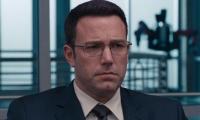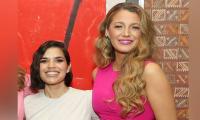People usually resort to clichéd photographs of the Frere Hall or Quaid-e-Azam’s mausoleum to explain Karachi to a stranger. But if we take a closer look, the sites fail to depict the richness of the city, which was why we decided to use pictures from areas that are usually unexplored even by residents, said Danial Shah, a documentary photographer, as he explained the idea behind the two-day event, ‘Yeh Hai Karachi: A Film and Photo Exhibition’.
Curated by Peace Niche, the exhibition held at Commune Artist Colony hosted works of 372 students from all six districts of the city – East, West, Central, South, Malir and Korangi - who participated in the sessions organised by The School of Writing (TSW).
“We wanted the participants to get acquainted with their own districts and put their cameras to use to narrate tales about the areas,” said Shah.
Representing the theme of peace, tolerance and global citizenship, one picture depicted a man praying on a barren land alongside a giant Cross, while some other pieces depicted the everyday life from angles that made it look extraordinary.
One of the participants, Shehzad from Hijrat Colony narrating his experience shared that the exercise helped him learn how to interact with people, “People usually get hesitant in front of a camera so we were taught to approach and speak to them way that removed their inhibitions. We built our trust before clicking their pictures. And getting to travel the city was another plus.”
‘Pictures speak’
A panel discussion with renowned photographers, Farah Mahbub, Arif Mehmood and Madiha Aijaz explored the change in culture of photography in the country - owed to the recent boom in Smartphone technology enabling anyone and everyone to snap a photograph.
Speaking about the cohesiveness of a society that one usually sees in pictures, Madiha said that the people depicted in a certain area may not be as united as the pictures shows. “Unnecessarily shoving a camera would never help, rather one should first familiarise themselves with the surroundings and the people before clicking a picture.”
Farah, who has documented architecture, said photography helped her understand a human mind; “When we look at the beautifully constructed buildings, we marvel at the art, yet, we also see the same structures reduced to rubble. This speaks volumes about hope for the future generation, that while humans destroy they also erect masterpieces which hold inspiration for people and bring them together.”
Further elaborating over the art, she said that anyone who was seeking to make a profit out of photography was in for a shock, because it takes years of hard work to become an acclaimed photographer.
“If you love someone, you will walk the distance for them completely ignoring what they are giving you in return. The same goes for passion; and as far as money is concerned, you won’t go to bed hungry.”
About ethics of photography, Mahmood said photography was an artful intrusion of a situation. “But if someone says no, I put my camera down and move away. It’s as simple as that. However in cases of photojournalism, photographers are required to be quick, but if one is unaccustomed to the scenario you end up losing the moments.”
With Karachi being the theme, the three photographers shared their relationship with their work in the context of the city they capture.
“For me it’s a visual diary. I am a photographer trying to learn about the city using this tool (camera) to come closer to people,” Mahmood stated.
For Madiha it was a sense of humility and photography helped her understand the city. Her work around temples aided her in comprehending the rituals as well.
“In my case, I believe when words fail pictures speak, and I use this to connect but it’s from a vantage point rather than a personal point of view,” said Farah.
A photo walk held around the city covering other places of exhibit namely, Cantt Railway Station, Civil Hospital, NJV School Courtyard, Lady Dufferin Hospital and City Station, was also a part of the event.
An aerial view of Karachi city. — AFP/FileCelebrating ShakespeareThe National Academy of Performing Arts is...
This representational image shows a woman touching a dead body's legs. — APP/FileThe woman killed on Wednesday in...
The University of Karachi entrance gate. — APP/FileThe role of educated mothers is crucial for the development of...
Secretary Information Department Nadeem-ur-Rehman Memon. — Facebook/Umerkot - Gateway to TharSecretary Information...
Commissioner Karachi Syed Hasan Naqvi chairs a meeting to assess the preparations for the upcoming 29th International...
Sindh’s chief secretary Syed Asif Hyder Shah chairs a meeting with the National Highway Authority on April 18,...







